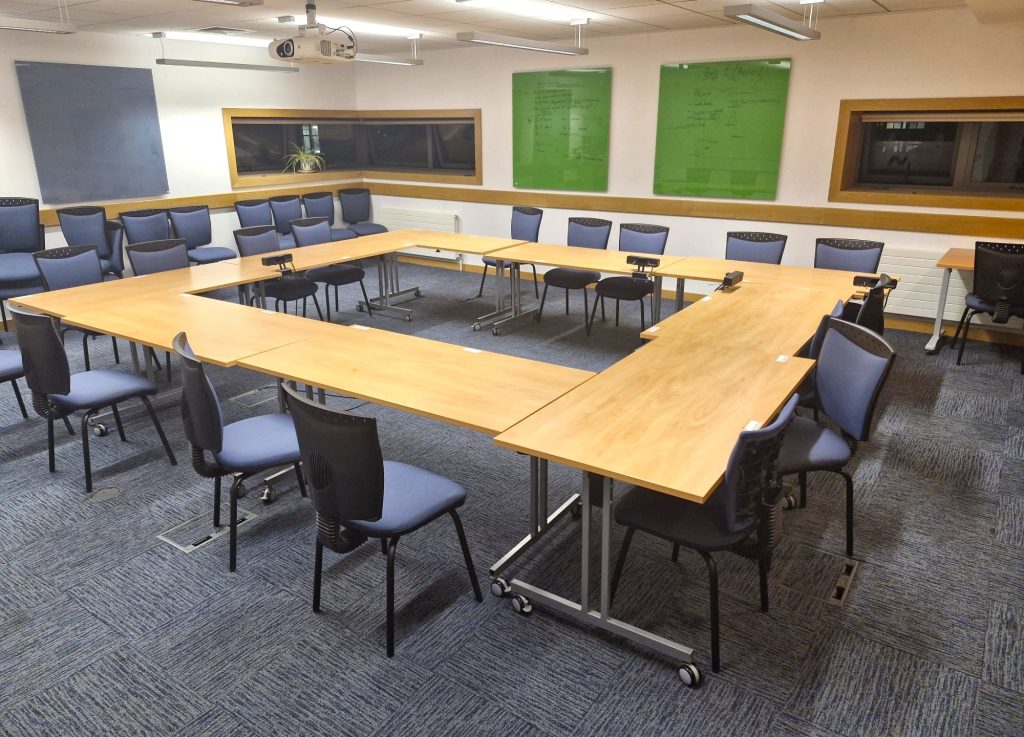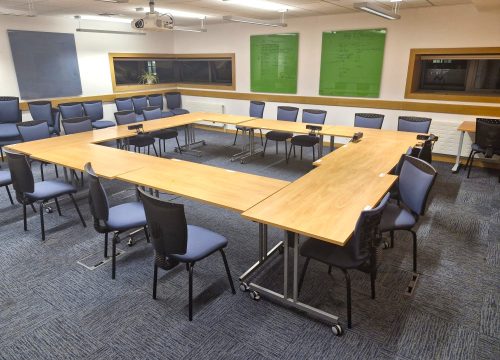Study Room Name Series: 3. The Fairlie Room
The Fairlie Meeting Room, located on the second floor of the Main Library, offers a versatile space suitable for teaching sessions, meetings, and collaborative work. Designed with a boardroom layout, it can comfortably accommodate up to 25 individuals. The room is equipped with chairs and double desks, providing a conducive environment for various academic and professional activities. The room can be booked through central room booking.

Why is it called The Fairlie Room?
The Inspiring Story of Professor Margaret Fairlie
At a time when women in medicine were often confined to the margins, Margaret Fairlie carved out a ground breaking path—not just for herself, but for generations of women to come. Known for her skill in gynaecology, her pioneering use of radium in cancer treatment, and her warm rapport with students, Fairlie made history in 1940 when she became the first woman to hold a professorial chair in Scotland.
From Angus to Academia
Born in 1891 on West Balmirmer Farm in Angus, Margaret Fairlie’s journey from rural roots to academic acclaim was anything but ordinary. She attended Arbirlot Public School and the Harris Academy before pursuing medicine at the University of St Andrews via University College, Dundee. After earning her MBChB in 1915, Fairlie trained across Dundee, Perth, Edinburgh, and Manchester, focusing on what would become her lifelong speciality: gynaecology.
A Career of Firsts
Returning to Dundee in 1919, Fairlie established a private consultancy and joined the teaching staff at the Medical School the following year—a role she would hold for nearly 40 years. But her contributions stretched far beyond the lecture hall.
Fairlie’s visit to the Marie Curie Foundation in Paris during the 1920s sparked her interest in the medical use of radium. Recognising its potential, she began using radium to treat malignant gynaecological diseases—making her a pioneer of its clinical application in Scotland. Committed to her patients, she even used her own savings to purchase radium for the Dundee Royal Infirmary, where she also set up dedicated follow-up clinics.
By the mid-1930s, she was head of Obstetrics and Gynaecology at the Infirmary and served as honorary gynaecologist at hospitals across Angus and Perthshire.
Breaking the Glass Ceiling
Despite her qualifications and contributions, Fairlie faced significant barriers in gaining formal academic recognition. Her appointment as a professor was delayed by both institutional tensions and a reluctance to see a woman in such a prestigious role. But in 1940, with the backing of her hospital colleagues, she was officially named Professor of Obstetrics and Gynaecology at the University of St Andrews (based in Dundee), shattering a glass ceiling that had long kept women out of Scotland’s top academic ranks.
She remained the only female professor in Scotland until her retirement in 1956, balancing her academic duties with her role as warden of West Park Hall, a women’s residence at the university.
A Life Rich in Service and Spirit
Fairlie never married, though she was engaged to fellow surgeon Professor Lloyd Turton Price before his untimely death in 1933. Known for her kindness, hospitality, and a surprising sense of humour (she famously kept a parrot), Fairlie was beloved by colleagues and students alike.
She was also an avid traveller, gardener, and painter—bringing creativity and curiosity to all aspects of life.
A Lasting Legacy
Margaret Fairlie passed away in 1963 after falling ill while visiting Florence. But her legacy lives on.
She received an honorary degree from the University of St Andrews in 1957 and remains celebrated for her contributions to medicine and education. Her name appears on the professorial board displayed in the University of Dundee, and her life is commemorated on the Dundee Women’s Trail and the Discovery Walk in Slessor Gardens.
In 2015, the University honoured her further with the inaugural Margaret Fairlie Lecture, delivered by Professor Dame Sally Davies and attended by Fairlie’s family.
Professor Margaret Fairlie wasn’t just a pioneer—she was a powerhouse. Her dedication, compassion, and courage helped redefine what was possible for women in science and academia. As we continue to celebrate trailblazers past and present, her story remains a shining example of perseverance and progress.
Source
This article draws on publicly available biographical and historical resources.
